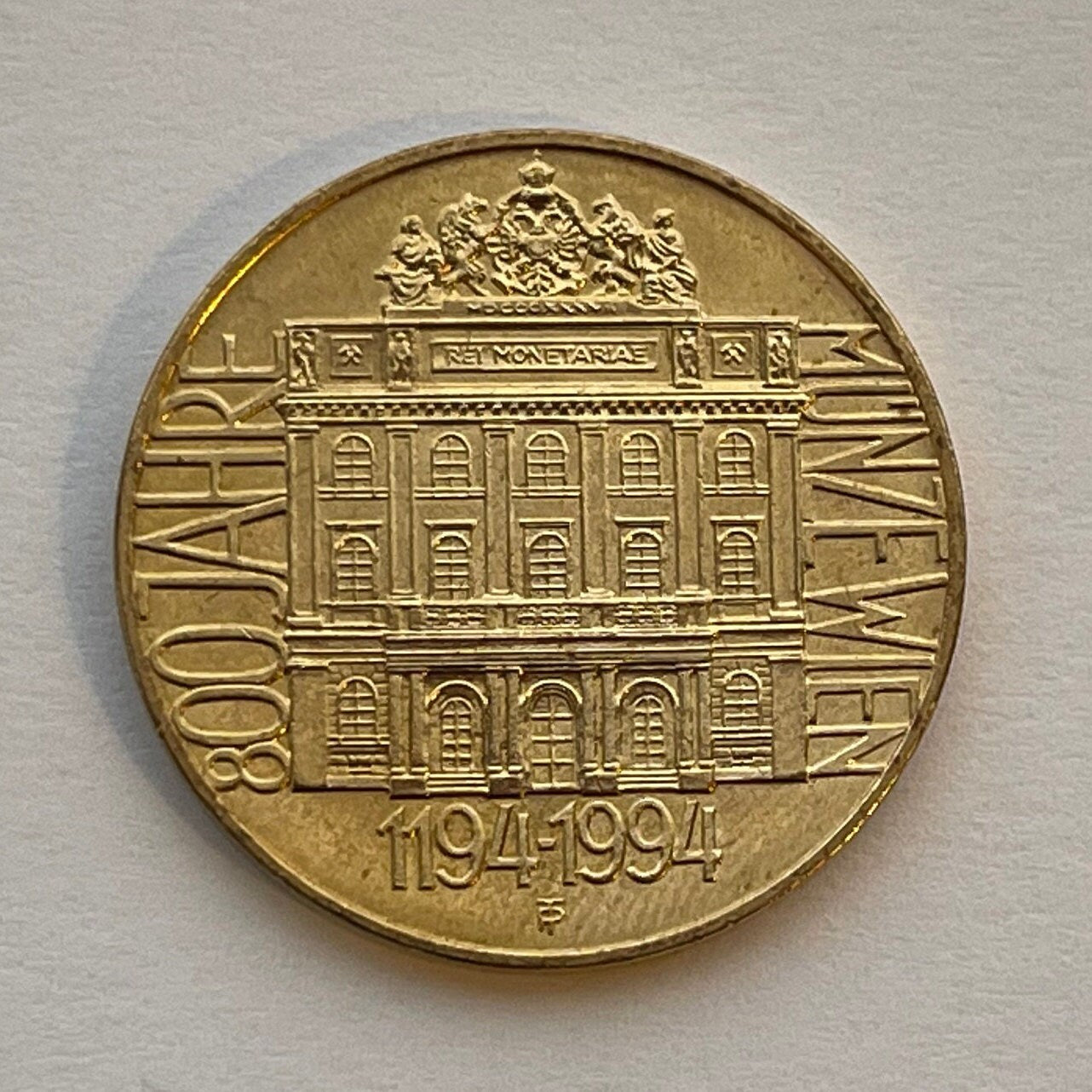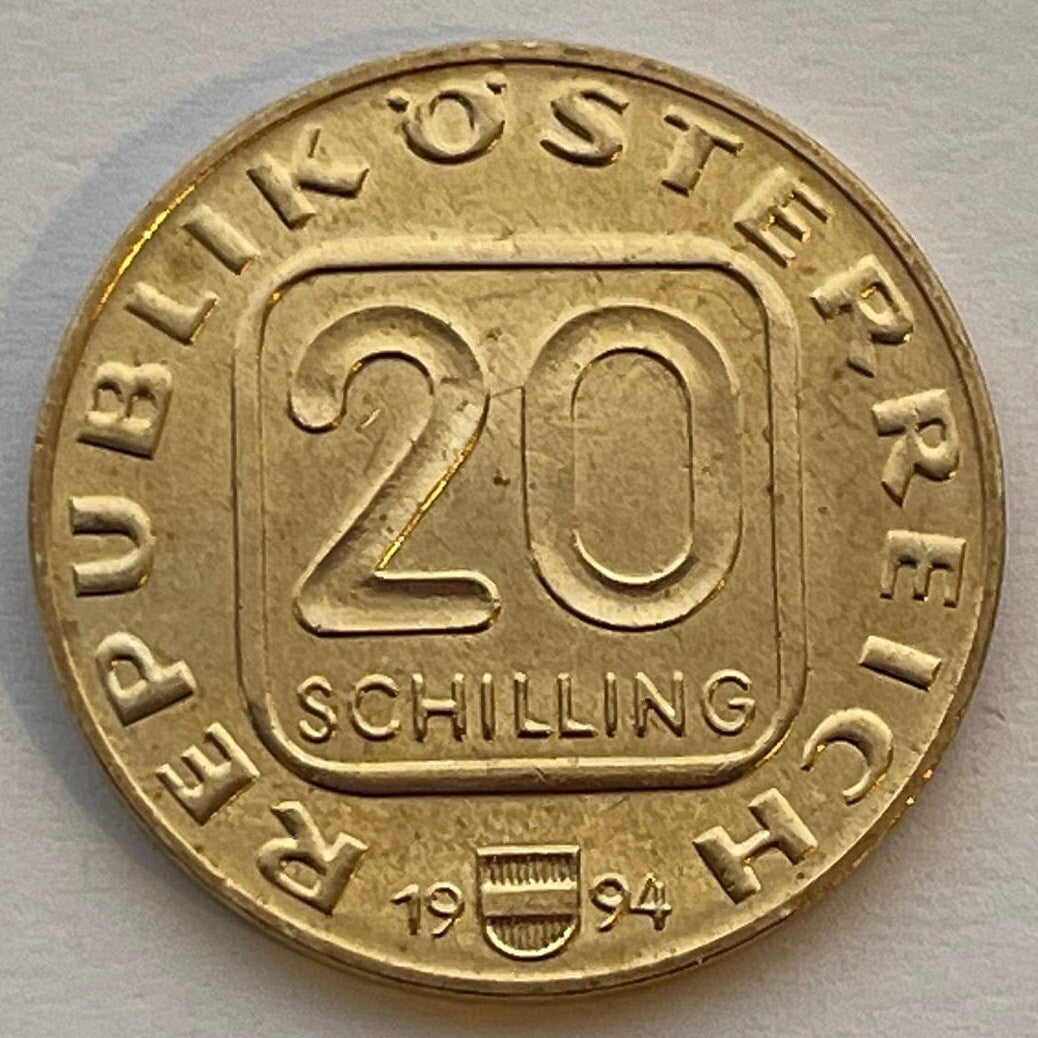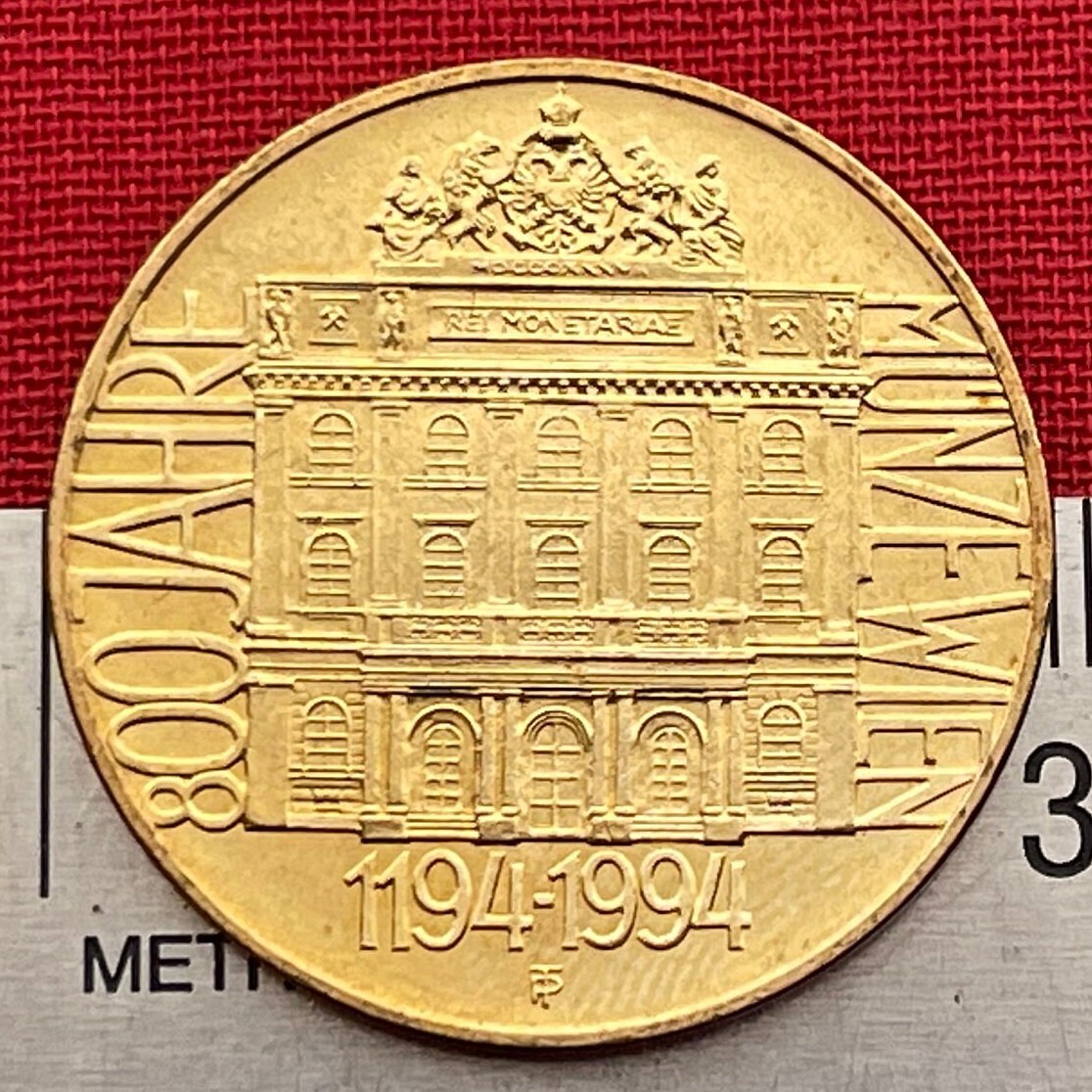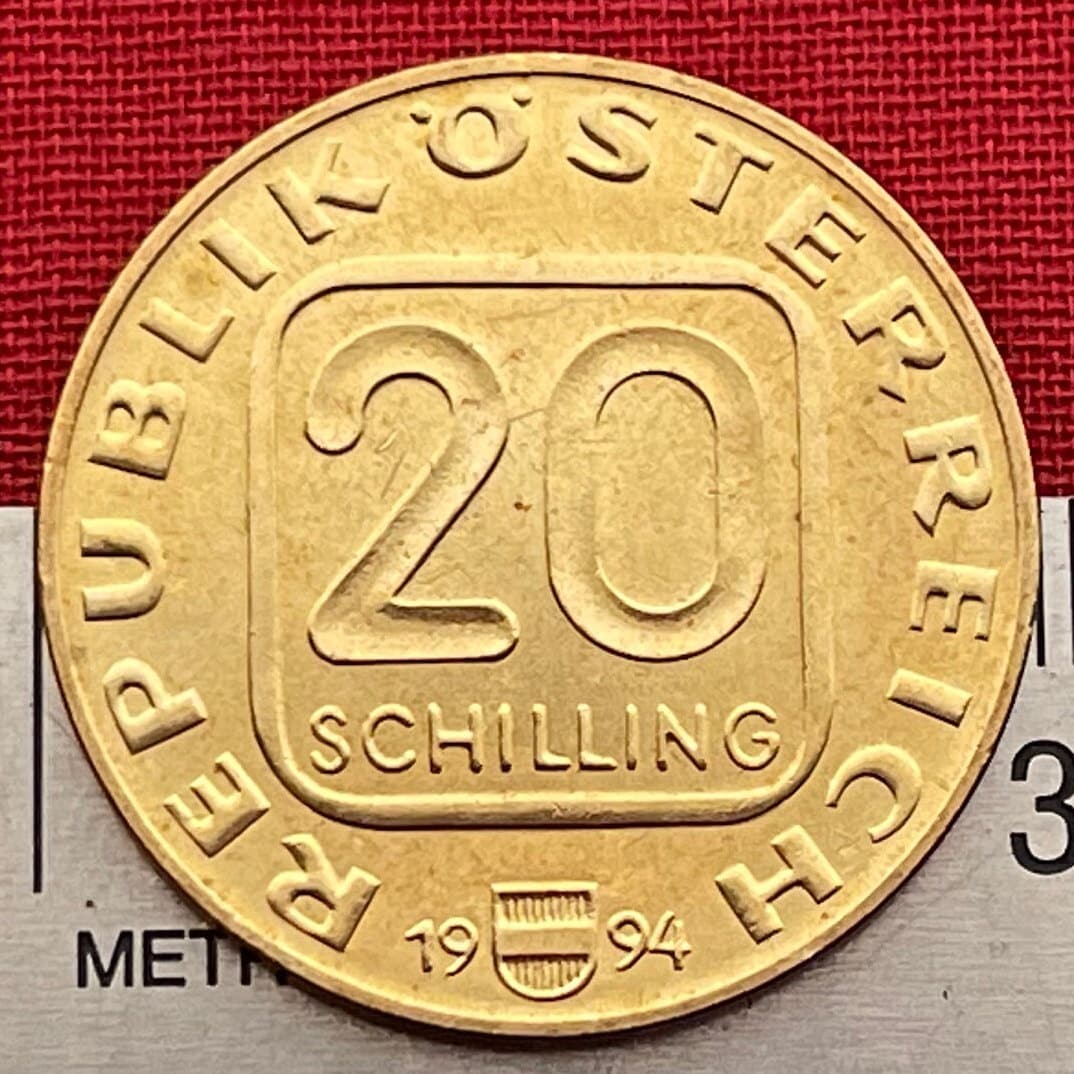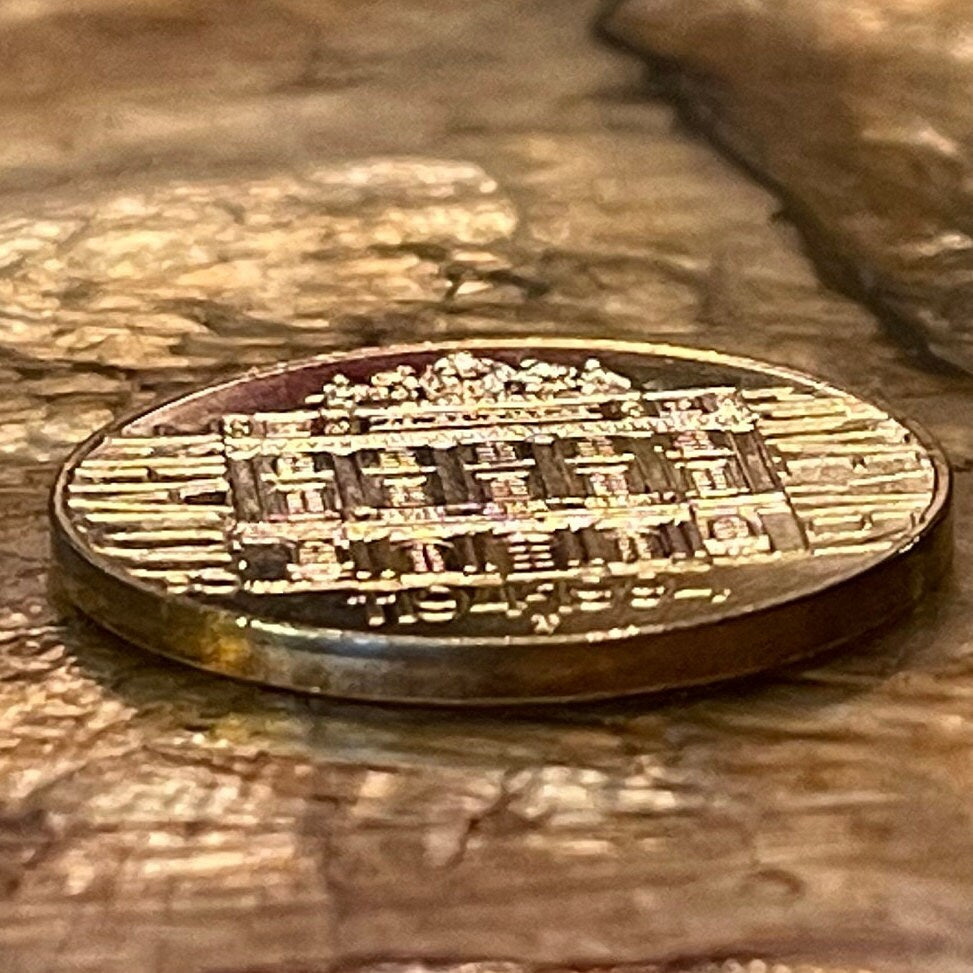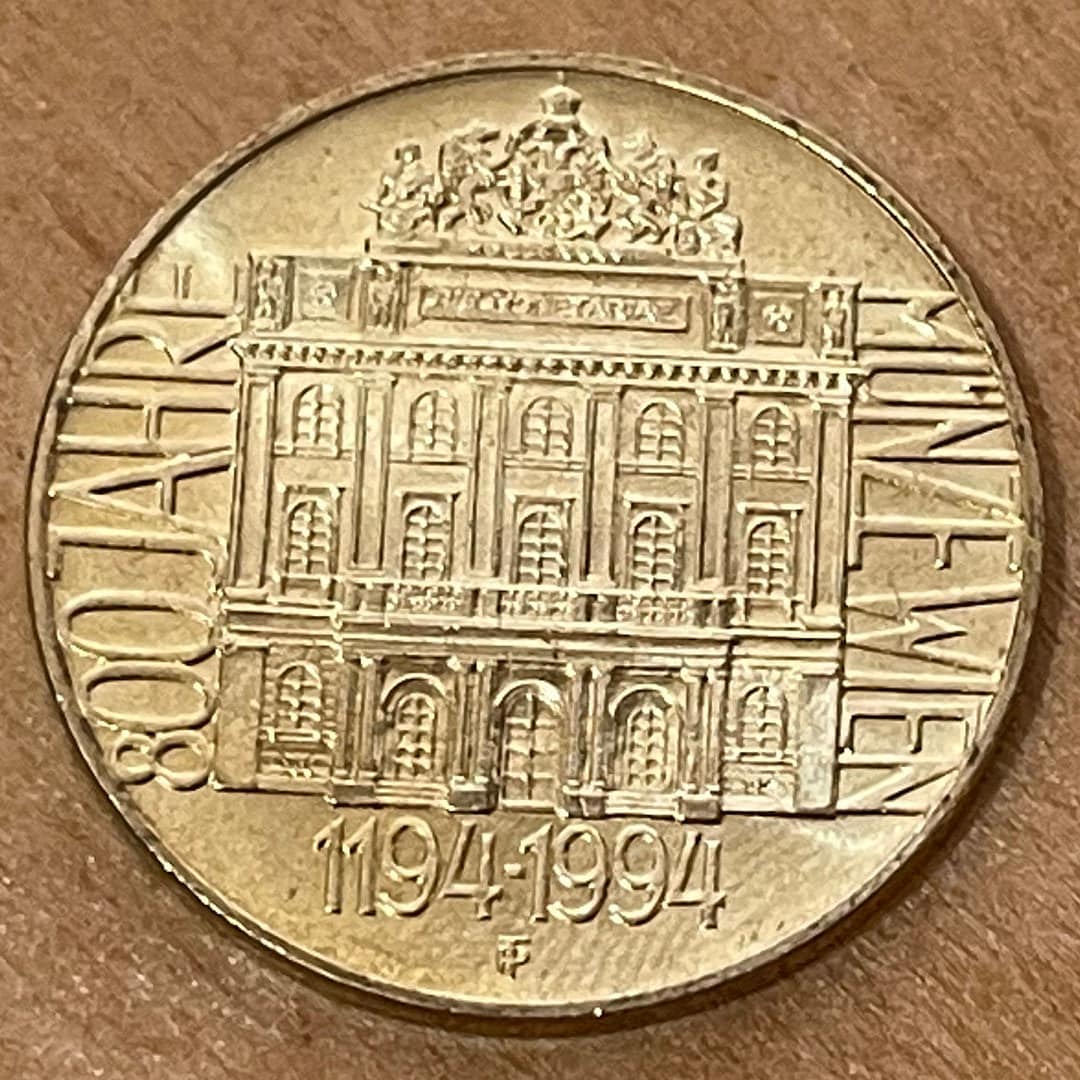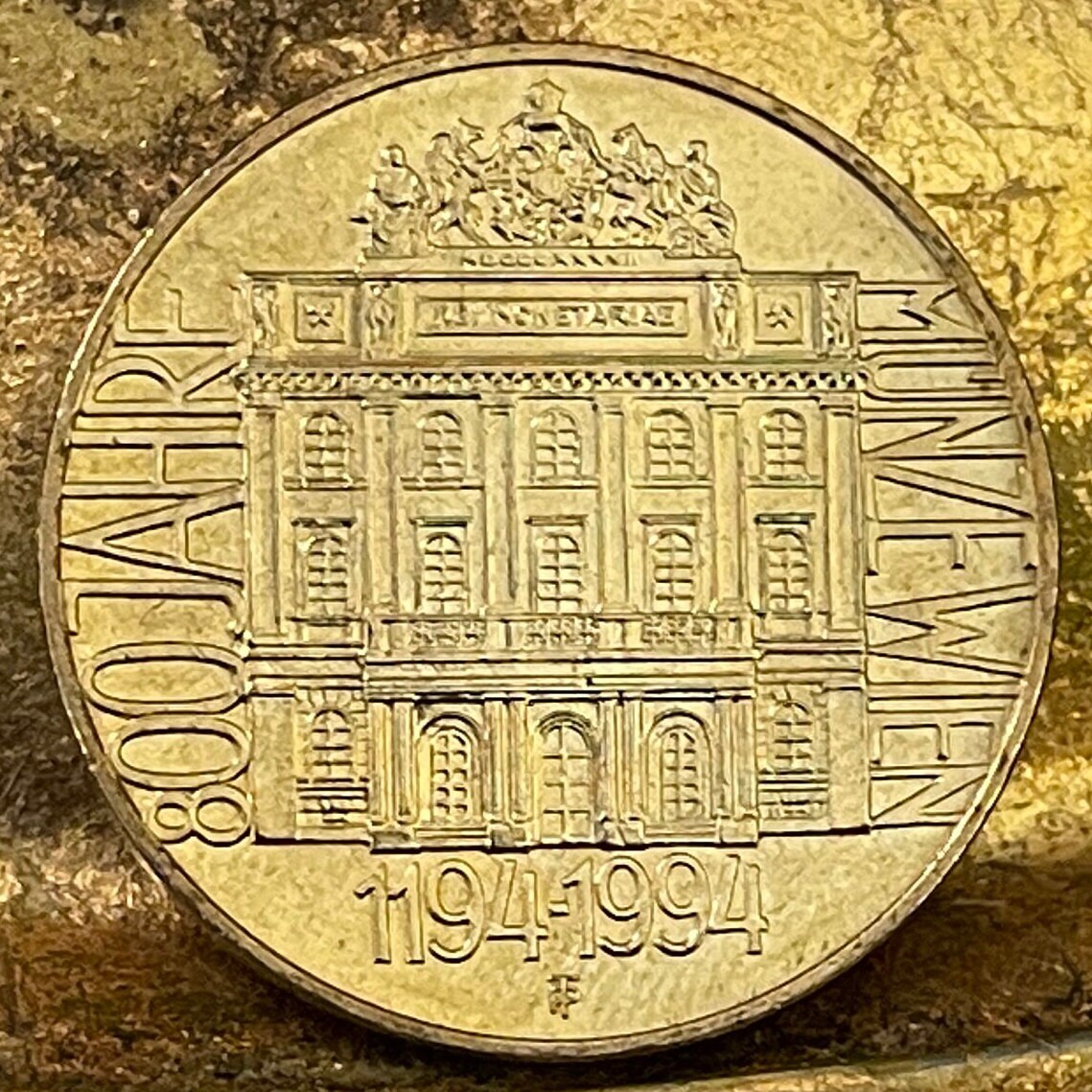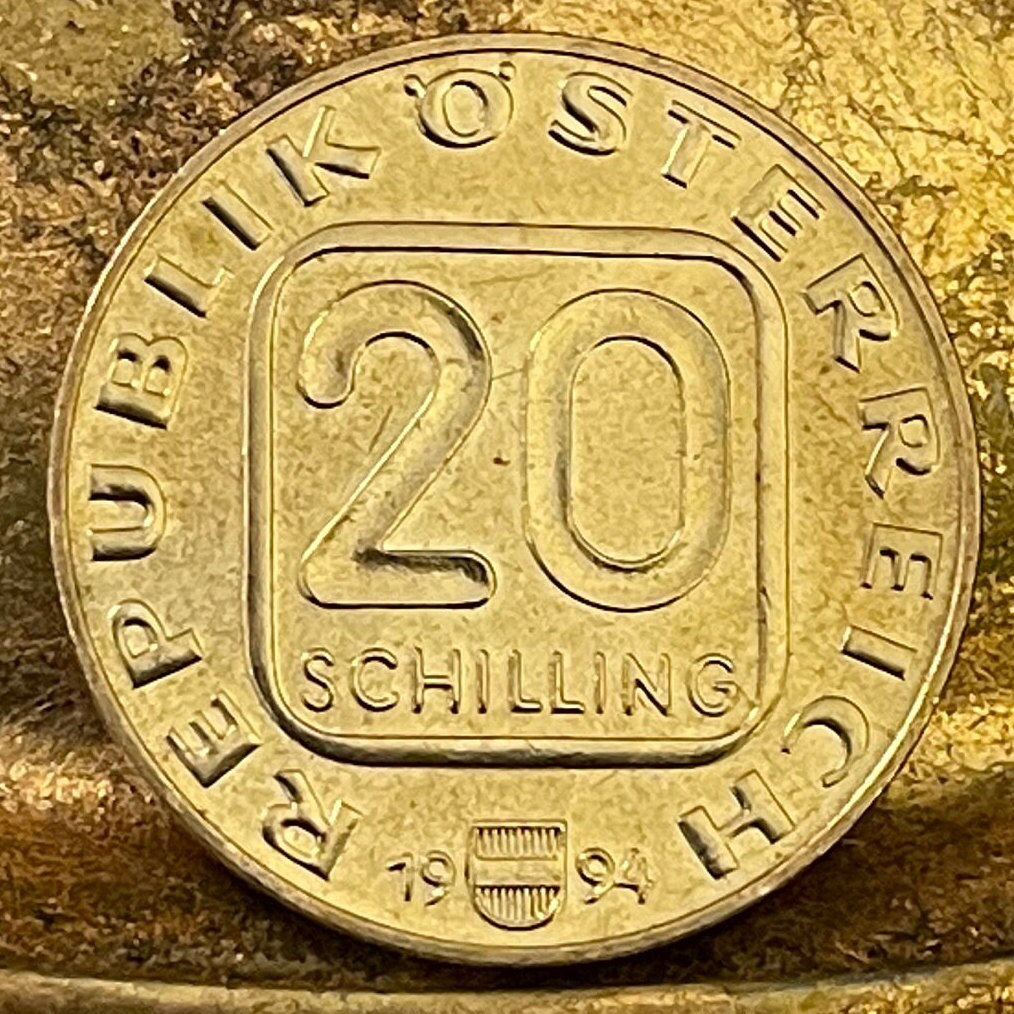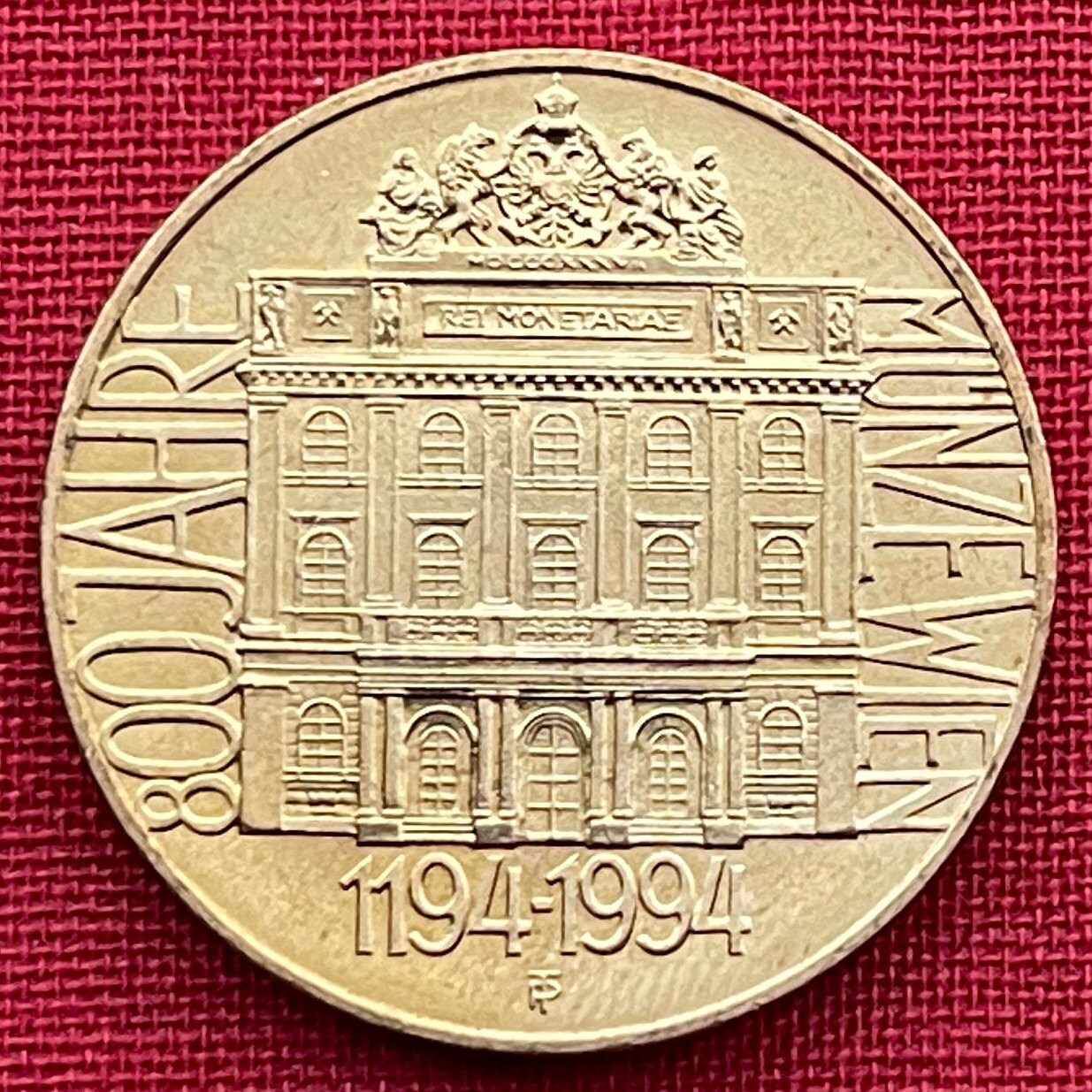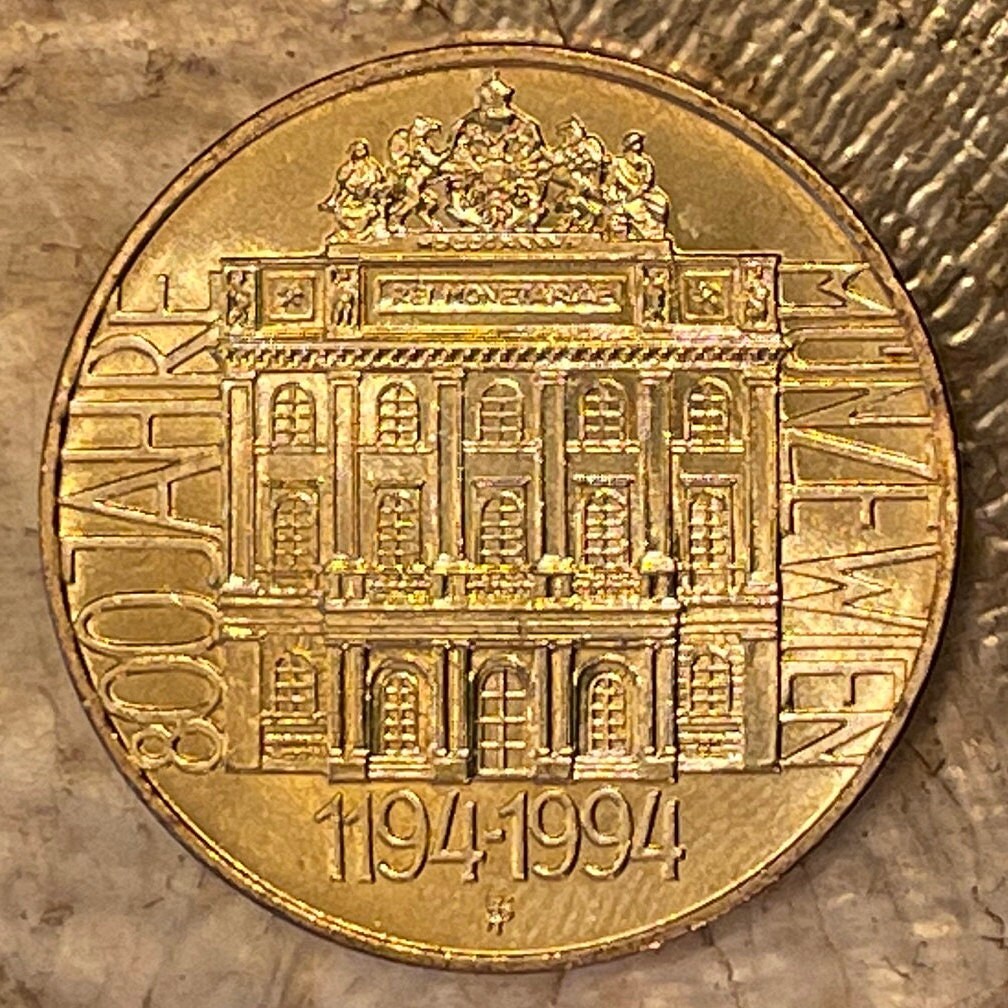elemintalshop
Vienna Mint (King's Ransom) 20 Schillings Austria Authentic Coin Money for Jewelry (1194) (Richard Lionheart) (Great Fortune Great Crime)
Vienna Mint (King's Ransom) 20 Schillings Austria Authentic Coin Money for Jewelry (1194) (Richard Lionheart) (Great Fortune Great Crime)
Couldn't load pickup availability
Vienna Mint 20 Schillings Austria Authentic Coin Money for Jewelry and Craft Making (1994) (800 Years) (Richard the Lionhearted Ransom)
Commemorative issue: 800 Years of Vienna Mint
Reverse:
MD CCC XXXVII
REI MONETARIAE
800 JAHRE MÜNZE WIEN
1194-1994
Translation:
1837 [i.e. the year of completion of this building]
Monetary Things
800 Years of Vienna Mint
1194-1994
Obverse: Lettering: REPUBLIK ÖSTERREICH
20 SCHILLING
Features
Issuer Austria
Period Second Republic (1945-date)
Type Circulating commemorative coin
Year 1994
Value 20 Schilling (20 ATS)
Currency Second Schilling (1945-2001)
Composition Aluminium-nickel-bronze
Weight 8 g
Diameter 27.8 mm
Thickness 1.9 mm
Shape Round
Orientation Medal alignment ↑↑
Demonetized 02-28-2001
Number N# 10089
References KM# 3016, Schön# 213
Wikipedia:
The Austrian Mint (German: Münze Österreich) is located in Vienna and is responsible for minting Austrian coins. Since 1989 it has been a public limited company (Aktiengesellschaft) and a subsidiary of Austria's central bank Oesterreichische Nationalbank, which also has its headquarters in Vienna.
The Austrian Mint carries out both the design and stamping of the coins it produces. Until 2002 it was only responsible for minting the coins of the Austrian schilling; since then it has been responsible for producing the Austrian euro coins. The mint also produces other coins, such as gold bullion coins, as well as commemorative issues: the Vienna Philharmonic coins and the Maria Theresa thaler are produced by the Austrian mint, for example. The mint also supplies circulation coins and blanks to many other countries across the world.
History
In 1194, Duke Leopold V of Austria was paid 15 tonnes of silver by Richard the Lionheart. On his way back from the crusades Richard had been captured and imprisoned by the Duke in retaliation for a previous insult; he paid the bounty to secure his release from prison. Leopold decided to strike coins from the silver, marking the beginning of the history of minting in Vienna (though the Vienna Mint was not actually mentioned in historical documents for another 200 years).
The mint was originally located near the Hoher Markt, then relocated to the Wollzeile. Subsequently, it was housed in Prince Eugene’s winter palace in Himmelpfortgasse, before finally moving to its present home at Heumarkt, central Vienna, in the 19th century. [Built between 1834 and 1838.]
Though other mints were established across Austria in the past, the Vienna Principal Mint became the sole mint when the Republic of Austria was formed in 1919. The mint changed its name to Münze Österreich ("Austrian Mint") as it became a subsidiary of Oesterreichische Nationalbank in 1989.
*******
Wikipedia:
Richard's captivity, ransom and return
Bad weather forced Richard's ship to put in at Corfu, in the lands of Byzantine Emperor Isaac II Angelos, who objected to Richard's annexation of Cyprus, formerly Byzantine territory. Disguised as a Knight Templar, Richard sailed from Corfu with four attendants, but his ship was wrecked near Aquileia, forcing Richard and his party into a dangerous land route through central Europe. On his way to the territory of his brother-in-law Henry the Lion, Richard was captured shortly before Christmas 1192 near Vienna by Leopold of Austria, who accused Richard of arranging the murder of his cousin Conrad of Montferrat. Moreover, Richard had personally offended Leopold by casting down his standard from the walls of Acre.
Leopold kept Richard prisoner at Dürnstein Castle under the care of Leopold's ministerialis Hadmar of Kuenring. His mishap was soon known to England, but the regents were for some weeks uncertain of his whereabouts. While in prison, Richard wrote Ja nus hons pris or Ja nuls om pres ("No man who is imprisoned"), which is addressed to his half-sister Marie. He wrote the song, in French and Occitan versions, to express his feelings of abandonment by his people and his sister. The detention of a crusader was contrary to public law, and on these grounds Pope Celestine III excommunicated Duke Leopold.
On 28 March 1193 Richard was brought to Speyer and handed over to Holy Roman Emperor Henry VI, who imprisoned him in Trifels Castle. Henry VI was aggrieved by the support the Plantagenets had given to the family of Henry the Lion and by Richard's recognition of Tancred in Sicily. Henry VI needed money to raise an army and assert his rights over southern Italy and continued to hold Richard for ransom. Nevertheless, to Richard's irritation, Celestine hesitated to excommunicate Henry VI, as he had Duke Leopold, for the continued wrongful imprisonment of Richard. Richard famously refused to show deference to the Emperor and declared to him, "I am born of a rank which recognises no superior but God". The king was at first shown a certain measure of respect, but later, at the prompting of Philip of Dreux, Bishop of Beauvais and Philip of France's cousin, the conditions of Richard's captivity were worsened, and he was kept in chains, "so heavy," Richard declared, "that a horse or ass would have struggled to move under them."
The Emperor demanded that 150,000 marks (100,000 pounds of silver) be delivered to him before he would release the King, the same amount raised by the Saladin tithe only a few years earlier, and two to three times the annual income for the English Crown under Richard. Richard's mother, Eleanor, worked to raise the ransom. Both clergy and laymen were taxed for a quarter of the value of their property, the gold and silver treasures of the churches were confiscated, and money was raised from the scutage and the carucage taxes. At the same time, John, Richard's brother, and King Philip of France offered 80,000 marks for Henry VI to hold Richard prisoner until Michaelmas 1194. Henry turned down the offer. The money to rescue the King was transferred to Germany by the Emperor's ambassadors, but "at the king's peril" (had it been lost along the way, Richard would have been held responsible), and finally, on 4 February 1194 Richard was released. Philip sent a message to John: "Look to yourself; the devil is loose".
*******
From "Oh, Vienna" - a blogpost by David G.W. Birch
https://blog.dgwbirch.com/?p=593
...At the siege of Acre in 1191, during the Third Crusade, Richard the Lionheart supervised the building of siege engines to breach the walls of the city and thus led to its fall in July of that year. He immediately quarrelled with Duke Leopold V of Austria over the spoils of war and eventually tore down Leopold’s banner and sent his army on their way, thus ending early attempts at a common European foreign policy in the Middle East. In October, after decapitating 2,800 prisoners in another dispute with Saladin, Richard left for England to stop his brother Bad King John (“Lackland”) from usurping him.
On his way back to England, Richard could not go through France because John had come to an agreement with Philip of France that closed French harbours to him. He instead came via the Adriatic and was making his way overland when he was captured by Leopold near Vienna on 20th December 1192. Stories of his capture vary, but the most plausible version of events seems to me to centre on coins. Richard was disguised as a merchant and sent his serving boy to the market to buy provisions, but gave him coins minted in Syria that did not fail to attract attention in an Austrian village! It would be the same as paying with a £50 note in the Woking Weatherspoons today – people would talk. The coin caused Leopold’s men to pay particular attention to the boy, who showed up in the market a couple of days later with Richard’s ornate and expensive gloves – at which point he was taken and tortured to reveal Richard’s location in a nearby tavern.
Leopold was quite rightly excommunicated for this kidnapping by Pope Celestine III (imprisoning a crusader really did cross the line in the twelfth century) but he didn’t seem that bothered. He first imprisoned Richard in Dürnstein Castle and then sold him to the Holy Roman Emperor, Henry VI (who was also excommunicated).
Henry demanded a ransom for 150,000 marks for the release of Richard. This is something in the region of two billion quid at today’s prices but that figure doesn’t quite convey the magnitude of the ransom. Sending two billion quid from London to Vienna can be done today with a transit van full of 500 euro notes, but in 1193, the problem of moving something like twice the total annual income of the English Crown across a thousand miles of warring European principalities took some amazing logistics. This was a unique episode in English history and had far-reaching consequences. In 2006 my good friend David Boyle, author of the brilliant “Blondel’s Song: The Capture, Imprisonment and Ransom of Richard the Lionheart”, gave a superb talk on this early experiment in pan-European cross-border multi-currency funds transfer at the Digital Money Forum in London and his observations on the unpredictable consequences on the transition from a feudal to a money economy were fascinating.
In particular, without the use of coins, no such ransom would have been possible. David writes about the profound impact of this ransom on English government, noting that while the “accounts may have long since disappeared – and may even have been destroyed by those who felt embarrassed by the public record of their generosity to Richard when his brother was on the throne” this episode marked the beginning of the shift from feudal payments to the very start of taxing income.
❄︎❄︎❄︎❄︎❄︎❄︎❄︎❄︎❄︎❄︎
It would be impossible to imagine collecting taxes on such a massive scale (or, indeed, at all) in many modern countries, so the feat of collecting such a large sum of money from a medieval economy should not be underestimated. It took an inventive series of taxes, enforced and collected, to get the King back. In fact “both clergy and laymen were taxed for a quarter of the value of their property, the gold and silver treasures of the churches were confiscated, and money was raised from the scutage and the carucage taxes”. Scutage was the tax paid by knights to get out of military service. Carucage was the land tax.
The authorities had imposed carucage on anyone with property worth more than ten shillings. But this didn’t bring in the anticipated revenue, so later on it was turned into a full-blown land tax. It was first imposed in 1194 and fell upon landowners at an initial rate of two shillings per 100 acres. After Richard died in 1199 to be succeeded by John, who my friend Dominic Frisby in his book “Daylight Robbery: How tax shaped our past and will change our future” rightly called “one of the most infamous tax collectors in history”. John raised scutage and carucage many times and these taxes became one of the main causes of the discontent leading to the Magna Carta in 1215. This seminal document owes its existence not only to taxes, of course, but to wider a economic crisis: bad harvests, shortage of coin—as we will see—inflation, disruption of trade and a general decline in productivity under John.
(If you are wondering why people refer to Bad King John, even Graham Seel’s 2012 book “King John: An Underrated King” explains that a contemporary chronicle “The History of William Marshall”, otherwise known as England’s greatest knight, calls John faithless, unwarlike, unwise, mean, nasty and suspicious. His critics called him far worse.)
Through scutage, carucage and other taxes, the English gathered several tons of silver. David says twenty tons, but in Alison Weir’s “Eleanor of Acquitaine: By the Wrath of God, Queen of England“, the figure implied is considerably higher, more like fifty tons. The money was brought to London in the form of treasure (melted down to form ingots) and coins, which were all silver in those days.
(My 1962 copy of “Money in Britain” says that there were no continuously minted gold coins in England until the reign of Henry III (1216-72). The coins for the ransom must have been mainly in the form of the silver pennies brought into existence under Richard’s father, Henry II. His mint master, Isaac the Jew, set the 92.5 percent pure silver standard which became known as the “the ancient right standard of England” and continued until the 1920s! In 1257 the twenty penny, that was one-twelfth of a pound Sterling, gold coin was struck. This didn’t last very long and in 1265 it was replaced with a twenty four penny “florin” worth one-tenth of a pound. There were still florin coins when I was a kid, as they were minted until 1967, but they didn’t have the same economic impact as Henry III’s florin which was worth a couple of hundred quid at today’s prices.)
Under Queen Eleanor’s direction, the growing piles of cash were stashed in the crypt of St. Paul’s, which was then the administrative centre of London. It took a long time to build the ransom there, since the Faster Payment System of the day was a horse and cart. When the Emporer’s men popped in in 1193 to see how things were coming along — checking out the tally sticks and the pipe rolls to assess the rate of collection and to take delivery of the first tranche of the ransom — there were only about fifteen tons of silver. This was loaded onto a fleet of ships and sent off to Henry. The collection continued and at the end of the year, on 20th December 1193, Queen Eleanor set off with the rest of the cash, arriving at Henry’s court on 17th January, so it only took three weeks.
The money was transported to Henry under a simple pre-PSD2 regulatory structure, known as the “King’s Peril”, which meant that were the money to have been lost along the way, it was an English problem. Until the money was actually in Henry’s hands then it was Richard’s responsibility, even in Henry’s lands. Eleanor made it, and handed the balance of the ransom over on 4th February and Richard was released. He landed back in England on 13th March 1194, bringing this incredible episode in English history to an end and the only records of the greatest tax raid in English history that remained were the tally sticks.
Why did they send atoms, rather than bits about atoms? They had no alternative. The bill of exchange, the standard cross-border payment instrument in these pre-Bitcoin times, was a century away. And in any case, bills of exchange were not cheap. Peter Spufford in his magnificent Power and Profit, the Merchant in Medieval Europe, talks about the “specie point” at which it became cheaper to transport bullion than to buy a bill of exchange! And while bills of exchange boosted the money supply for commerce, they did not replace bullion, as sooner or later imbalances would need to be settled and so the wagon trains of gold and silver would rumble between trading centres.
The colossal ransom paid for Richard had some considerable consequences. The impact on Austria remains to this day. Leopold’s share of the ransom was used to build the new city walls of Vienna as well as to found the towns of Wiener Neustadt and Friedberg in Styria. It was also used to found the Austrian mint in 1194 to make coins from the silver handed over. This had an impact across central Europe as other rulers began to centralise their coinage too and local currencies began to vanish. Henry VI also created a new silver coinage (in Sicily).
✡︎✡︎✡︎✡︎✡︎✡︎✡︎✡︎✡︎✡︎✡︎
The impact back in England was also long lasting, and for one group of people in particular it was catastrophic. The Jews who, though few in number, were central to the economic life of England. This is why, as David Carpenter’s detailed commentary on the Magna Carta (released on the 800th anniversary in 2015) makes clear, there a several references to them in the Great Charter itself.
Throughout this period, the Jewish community in England were called upon to extend huge loans to the Crown to add to the ransom. This had a terrible consequence, because in order to provide these loans they had to call in their loans to other people — minor aristocrats, farmers, business people and so on — which caused great resentment against their community rather than the King (which was, of course, why it was done). In March 1194 a conference of Jewish financiers was organised in Northampton and representatives from major cities attended, other than (for example) York and Bury St. Edmunds, since the Jews in those places had already been slaughtered in the pogroms of 1190.
(These were widespread. Paul Johnson’s A History of the Jews, for example, tells how “all the Jews who were found in their own houses in Norwich were slaughtered”.)
The purpose of the 1194 conference was to work out how much more the Jews could contribute to the ransom, as indeed they were called on to do. Under Richard, there had been an inquiry into the pogroms and Christian-Jewish financial supervision committees created. David says these were partly an early attempt at banking regulation and partly to protect the Jewish community in return for its considerable contributions to the ransom. Christopher Dyer explores this further in Making a Living in the Middle Ages—The People of Britain 850-1520, saying that the Jews were the Crown’s mechanism for indirectly taxing landowners. The heavy taxes imposed on the Jewish community were passed on in interest rates, so that the common borrowers would blame the Jews rather than government spending for their reduced circumstances. Having come to England after the Norman conquest as moneychangers and bullion dealers, England’s Jews were reduced by a combination of taxation and murder until they were eventually expelled in 1290.
✡︎✡︎✡︎✡︎✡︎✡︎✡︎✡︎✡︎✡︎✡︎
A side effect of the silver exodus form England was that while local currencies circulated to substitute for the missing pennies for a while, the money literally ran out. After all, a quarter of England’s coinage had vanished (which David calls a “deflationary shock that England needed”), but somehow commerce continued. In the absence of a medium of exchange. Spufford reminds us that “Only in the short run did political, or occasionally religious, actions have greater effects than trade balances on the large-scale movement of silver and gold, coined and uncoined”.
It is an astonishing testament to England’s medieval wealth and administration that the very, very high level of taxation necessary to pay that (literally) King’s Ransom could be imposed and collected, yet in the long run the economy survived and grew.
20th December should be remembered in London and in Vienna.
* **
https://www.songfacts.com/facts/richard-the-lionheart/ja-nus-hons-pris
Also spelt "Ja Nuis Om Pres," this translates as "No Man Who Is Imprisoned." It has also been called "Song Of Captivity" and "King Richard's Ballad" It was written originally in French (i.e. the French language of the day) and the now endangered language Occitan by Richard The Lionheart, King of England.
Richard ascended to the Throne in 1189. In 1192 while returning from his third crusade, he was captured and held prisoner by Leopold V, Duke of Austria, and held prisoner. He was handed over to Henry VI, Holy Roman Emperor, and while languishing in captivity, wrote this song as an address to Marie of France, Countess of Champagne, who was also his half-sister.
"Ja Nus Hons Pris" has been recorded by Owain Phyfe (who played with Blackmore's Night) and by Bryan Ferry.
Bryan Ferry covered this on his 2002 album Frantic, making this 35-second French medieval ballad one of the few songs recorded by a major recording star that was originally penned by an English king. (Though "Greensleeves" has long been attributed to Henry VIII, there is no historical proof that the much-married monarch actually composed the tune). The song is credited to one Richard Couer de Lion, (arrangement by Bryan Ferry and Colin Good.) Richard Coeur de Lion (Richard the Lion Heart) was the nickname of the French-speaking Richard I of England.
Richard I of England (1157-1199) was bought up at his French mother's court at Poitiers in Aquitaine, speaking French and Provencal. He was highly educated and trained in knightly chivalry and from an early age the prince was writing verse. As he grew older, Richard started writing ballads, which were poems telling a tale with a mandolin or similar instrument backing, written in medieval French.
Though most likely apocryphal, this musical tale is worth retelling:
Shortly before Christmas 1192 Richard I was captured near Vienna by Leopold V, Duke of Austria, who accused the English monarch of arranging the murder of his cousin Conrad of Montferrat. Moreover, Richard had personally insulted Leopold by casting down his standard from the walls of Acre during the Third Crusade. Duke Leopold kept him prisoner at Dürnstein Castle.
At first no one in England knew where their king was. A minstrel called Blondel searched for his master throughout Europe in vain. Returning home through Austria he learnt there was a closely guarded prisoner whose identity was a secret nearby. Suspecting it could be his master, he located a tiny barred window high up on the castle wall which he thought could be a cell. Under the window he sang the first couplet of a Troubadour's song which he had composed, a voice responded with the second couplet. It was the King.
After being found by Blondel, Richard was handed over to Henry VI, Holy Roman Emperor. It was while languishing in captivity as the Holy Roman Emperor's prisoner that the monarch wrote this song as an address to Marie of France, Countess of Champagne. Eventually, the English people paid a huge ransom to set him free.
Share
